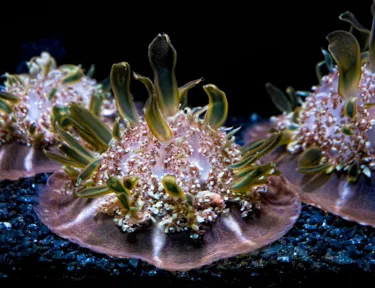Upside down Jellyfish
- Tuesday 11th September 2012
- Jellyfish

Upside down jellyfish are a rather unique jelly. Unlike other Jellies, that float and swim around wherever the currents take them, these jellies have decided to check out life from another angle. They have tipped themselves upside down (hence the name) and settle their tentacles up, resting their bells on the ground. They are usually found in calm shallow water, such as shallow lagoons and estuary areas in tropical waters. Often they are found in extremely large numbers, completely carpeting the bottom of lagoons with hundreds of little pulsing bodies.
Many people have an instinctive fear of anything 'jellyfish' due their renowned stinging ability. But while a blue bottle can give a nasty sting and box jellyfish can be deadly, not all jellyfish will cause serious harm. The moon jellyfish, for example, is completely harmless. The upside down jellyfish will not give a painful sting, but they do still have stinging cells on their tentacles, so brushing up against these can leave an itchy rash. Moral to the story, if in doubt: Don't Touch.
Like all jellies, upside down's have a polyp phase of their life cycle, during which they look like a small anemone attached to the ground. From this polyp, little "baby" jellies, called ephyra "bud" off the end of the polyp starting the next phase of their life cycle as a swimming medusa, looking like miniature adults only a few millimetres across. Feeding on tiny plankton, these babies quickly grow larger, until you have jellies about 20cm (like ours on exhibit) which have striking blue and brown colours on their bell and white tentacles.
Interestingly, as well as feeding on zooplankton, this jellyfish also harbours a photosynthetic algae found in the green leaf like stalks stretching up from within their arms. These algae harvest sunlight, just like their cousins in corals and the jellyfish can use this energy to grow faster.
You can see these incredible animals at SEA LIFE Sydney Aquarium's new Sydney Harbour exhibit.
Pre-book your tickets to the new SEA LIFE Sydney Aquarium and be one of the first to see all the new developments and SAVE!